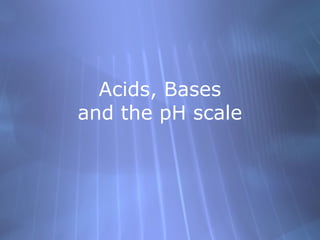
Acids bases
- 1. Acids, Bases and the pH scale
- 2. Vocab you need to know Solution: A uniform mixture that contains a solvent and at least one solute. (Example: Sugar Water) (hint- if you can see through it and it all looks the same it’s probably a solution) Solvent: the part of a solution that has the most quantity. In sugar water, this would be the water Solute: the substance that is present in a solution in a smaller amount. In sugar water, this would be the sugar
- 3. More Vocab… Colloid: a mixture that contains small, undissolved particles that do not settle out. A colloid contains larger particles than a solution but they are still too small to see. EXAMPLE: Milk (fats, proteins, water) hint: if you cannot see through it and it all looks the same, it’s probably a colloid)
- 4. More… Suspensions: a mixture where particles can be easily seen and can be separated by settling or filtration. EXAMPLE: A snow globe (you can see through it, but you can also see specific particles that are part of the mixture.)
- 5. Saturated vs. Unsaturated When you have added so much solute to a solution that no more can dissolve, then you have a saturated solution. When you can still add more solute and it continues to dissolve into the solution, then you have a unsaturated solution.
- 6. Acids An Acid is a chemical compound, that, when dissolved in water has a pH of less than 7. Acids taste sour, react with metals and carbonates and will turn blue litmus paper red. Acids are corrosive- they eat away at other materials.
- 7. Bases Bases are chemical compounds that, when dissolved in water, have a pH of above 7. Bases taste bitter, feel slippery and turn red litmus paper blue. Bases are corrosive- they eat away materials.
- 8. Uses for Acids: Acids are naturally in many of the foods we eat :Tomatoes, lemons, oranges, and even leafy green veggies! Acids are also used in many fertilizers. Acids can also be found in batteries
- 9. Uses for Bases Cement is made using bases Many cleaning solutions used in the home are bases (drain cleaner, glass cleaner, bleach, soap) Bases can also be found in baked goods such as breads, cakes, and cookies!
- 10. The pH scale!!!! The pH scale is a range of values from 0-14 that express the concentration of hydrogen ions in a solution. The more hydrogen ions, the lower the number on the pH scale.
- 11. Acids & Bases on the pH scale Acids range from 0-6.9 Acids have the most amount of hydrogen ions. Bases range from 7.1-14 Bases have the least amount of hydrogen ions. 7 on the scale is neutral (neither)
- 13. Neutralizing Acids & Bases The reaction between acids and bases is a called neutralization. The neutralization of acids and bases depends on the identities, volumes and concentrations of the reactants. Salts will typically form as a result of acids and bases neutralizing.